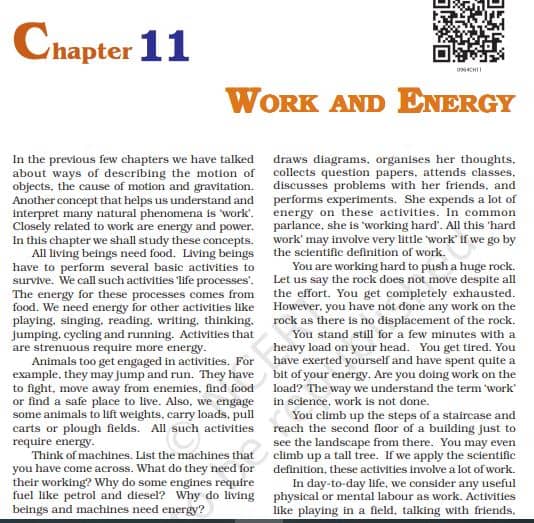‘Work Power and Energy Class 9’ PDF Quick download link is given at the bottom of this article. You can see the PDF demo, size of the PDF, page numbers, and direct download Free PDF of ‘Work Power And Energy Class 9 Notes’ using the download button.
Work Power And Energy Class 9 Textbook PDF Free Download

Exxplanation Of Work, Power And Energy
Work
What is work? There is a difference in the way we use the term ‘work’ in day-to-day life and the way we use it in science. To make this point clear let us consider a few examples.
Scientific Conception Of Work
To understand the way we view work and define work from the point of view of science, let us consider some situations:
Push a pebble lying on a surface. The pebble moves through a distance. You exerted a force on the pebble and the pebble got displaced. In this situation work is done. A girl pulls a trolley and the trolley moves
through a distance. The girl has exerted a force on the trolley and it is displaced. Therefore, work is done.
Lift a book through a height. To do this you must apply a force. The book rises up. There is a force applied on the book and the book has moved. Hence, work is done.
A closer look at the above situations reveals that two conditions need to be satisfied for work to be done: (i) a force should act on an object, and (ii) the object must be displaced.
If any one of the above conditions does not exist, work is not done. This is the way we view work in science.
A bullock is pulling a cart. The cart moves. There is a force on the cart and the cart has moved. Do you think that work is done in this situation?
WORK DONE BY A CONSTANT FORCE
How is work defined in science? To understand this, we shall first consider the case when the force is acting in the direction of displacement.
Let a constant force, F act on an object. Let the object be displaced through a distance, s in the direction of the force. Let W be the work done. We define work to be equal to the product of the force and displacement.
Work done = force × displacement
W = F s.
Energy
Life is impossible without energy. The demand for energy is ever increasing. Where do we get energy from? The Sun is the biggest natural source of energy to us.
Many of our energy sources are derived from the Sun. We can also get energy from the nuclei of atoms, the interior of the earth, and the tides. Can you think of other sources of energy?
The word energy is very often used in our daily life, but in science we give it a definite and precise meaning.
Let us consider the following examples: when a fast moving cricket ball hits a stationary wicket, the wicket is thrown away.
Similarly, an object when raised to a certain height gets the capability to do work.
You must have seen that when a raised hammer falls on a nail placed on a piece of wood, it drives the nail into the wood.
We have also observed children winding a toy (such as a toy car) and when the toy is placed on the floor, it starts moving.
When a balloon is filled with air and we press it we notice a change in its shape. As long as we press it gently, it can come back to its original shape when the force is withdrawn.
However, if we press the balloon hard, it can even explode producing a blasting sound.
In all these examples, the objects acquire, through different means, the capability of doing work. An object having a capability to do work is said to possess energy.
The object which does the work loses energy and the object on which the work is done gains energy.
How does an object with energy do work? An object that possesses energy can exert a force on another object.
When this happens, energy is transferred from the former to the latter.
The second object may move as it receives energy and therefore do some work.
Thus, the first object had a capacity to do work. This implies that any object that possesses energy can do work.
| Author | NCERT |
| Language | English |
| No. of Pages | 14 |
| PDF Size | 1.13 MB |
| Category | Education |
Related PDFs
Carbon And Its Compounds Class 10 PDF
Work And Energy Class 9 PDF Free Download
